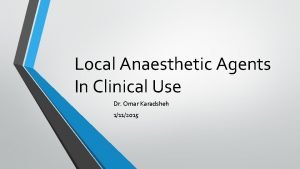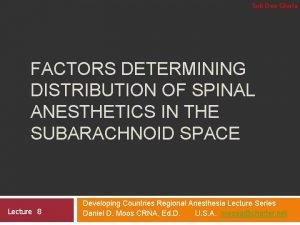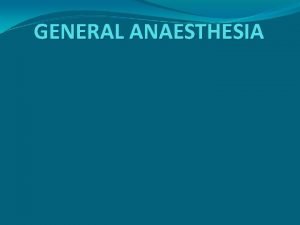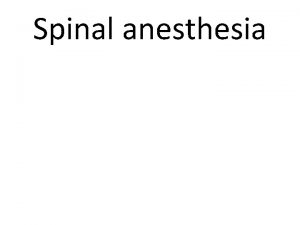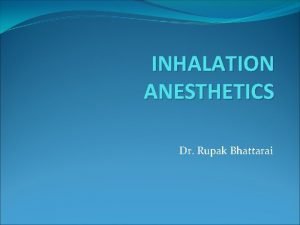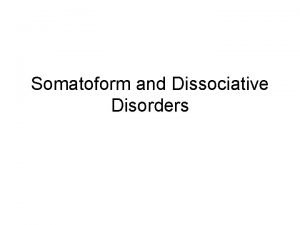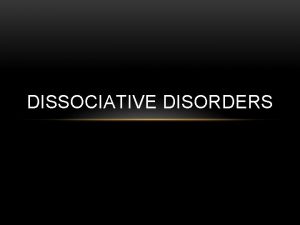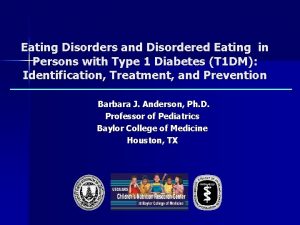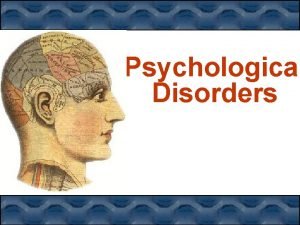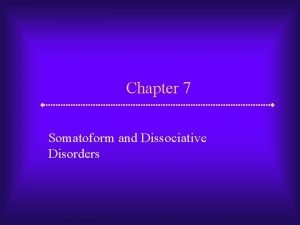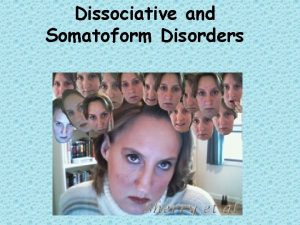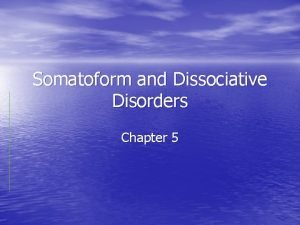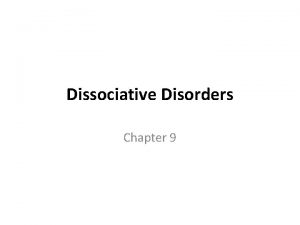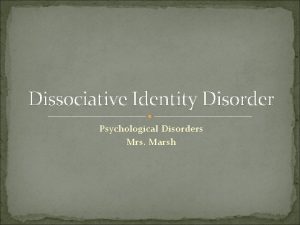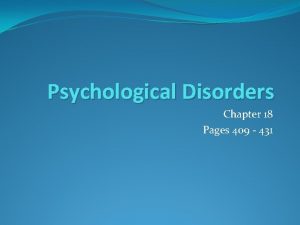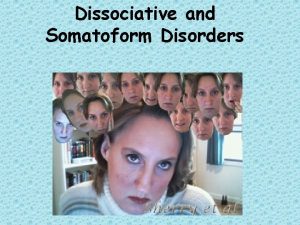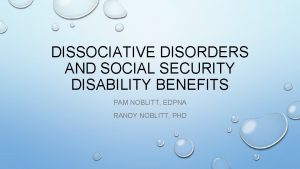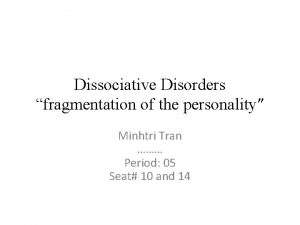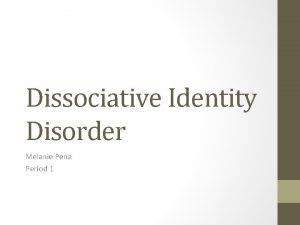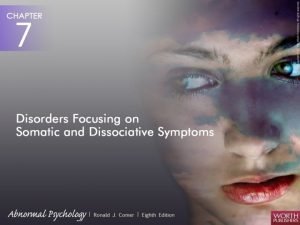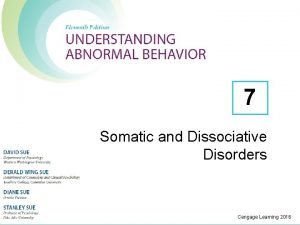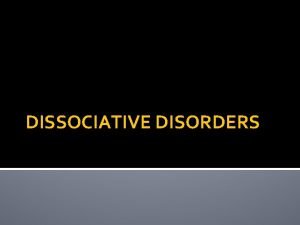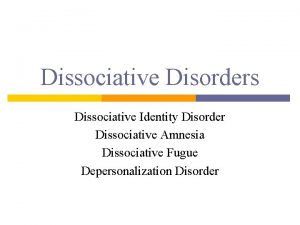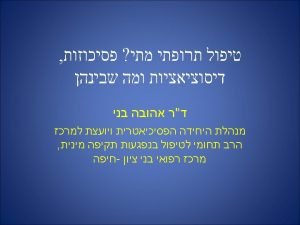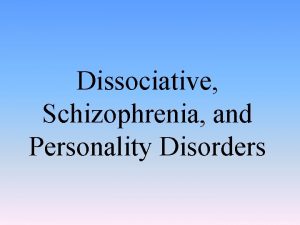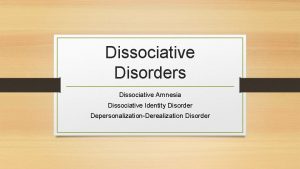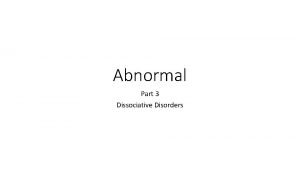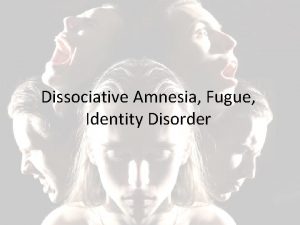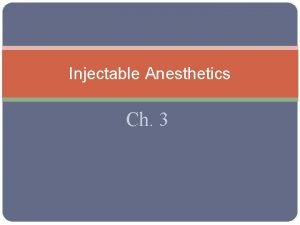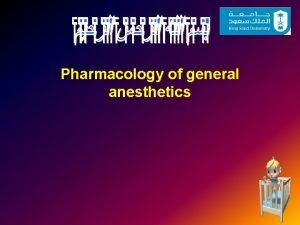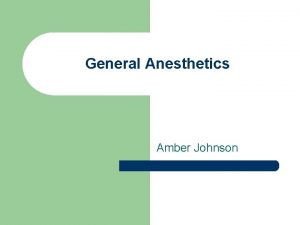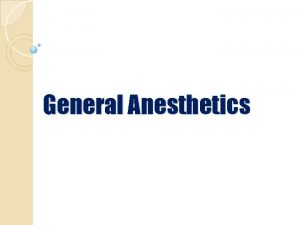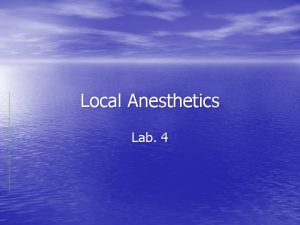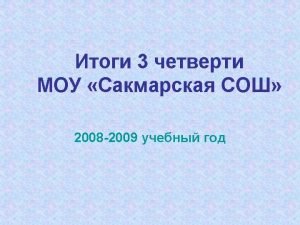Session 16 Dissociative Anesthetics 100 Minutes Session 16




































- Slides: 36

Session 16 – Dissociative Anesthetics 100 Minutes Session 16 Dissociative Anesthetics Drug Recognition Expert Course

Session 16 – Dissociative Anesthetics Learning Objectives • Explain a brief history of Dissociative Anesthetics and specifically PCP and its analogs • Identify common drug names and terms associated with this drug category • Identify common methods of administration for this drug category • Describe the symptoms, observable signs and other effects associated with this drug category Drug Recognition Expert Course 16 -2

Session 16 – Dissociative Anesthetics Learning Objectives (Cont. ) • Describe the typical time parameters associated with this drug category • List the clues that are likely to emerge when the drug influence evaluation is conducted for a person under the influence of this drug category • Correctly answer the “topics for study” questions at the end of this session Drug Recognition Expert Course 16 -3

Session 16 – Dissociative Anesthetics Overview of Dissociative Anesthetics • Drugs that inhibit pain by cutting off or dissociating the brain’s perception of pain • Induce a state of sedation, immobility, amnesia and analgesia Drug Recognition Expert Course 16 -4

Session 16 – Dissociative Anesthetics Phencyclidine (PCP) Phenyl Cyclohexyl Piperidine • Produces some effects that are similar to the effects of CNS Depressants • Produces some effects that are similar to those of CNS Stimulants • In some respects it acts like a Hallucinogen Drug Recognition Expert Course 16 -5

Session 16 – Dissociative Anesthetics Brief History of PCP • Developed in the late 1950’s • An effective intravenous anesthetic • Patented in 1963 under trade name of “Sernyl” • Used in treating mental and psychological disorders Drug Recognition Expert Course 16 -6

Session 16 – Dissociative Anesthetics Brief History of PCP (Cont. ) • Produced undesirable side effects • Use as an anesthetic for humans was discontinued in 1967 • Re-patented in 1968 as an animal tranquilizer under the trade name of “Sernylan” Drug Recognition Expert Course 16 -7

Session 16 – Dissociative Anesthetics Manufacture of PCP • Relatively easy • Chemicals available commercially • Formula for producing PCP has been widely publicized. • Basic hardware Drug Recognition Expert Course 16 -8

Session 16 – Dissociative Anesthetics Common PCP “Street Names” • Krystal • Ace • • Amoeba Trank Jet Fuel Juice Dust Magic Dust Monkey Dust Crystal Joints Drug Recognition Expert Course • • KJ (Or CJ) Devil Dust KJ Krystal Angel Dust Krystal Joints Embalming Fluid Monkey Tranquilizer Lovely 16 -9

Session 16 – Dissociative Anesthetics More PCP “Street Names” • • • Peace Pill Paz Green Elephant Tranquilizer Horse Tranquilizer Animal Tranquilizer Green Leaves Tic Tac Drug Recognition Expert Course • • • Kools Super Grass Super Weed Zombie Weed Peace Weed Mint Weed Killer Weed Sherms 16 -10

Session 16 – Dissociative Anesthetics PCP and Analogs Methods of Ingestion • Smoking Drug Recognition Expert Course 16 -11

Session 16 – Dissociative Anesthetics PCP and Analogs Methods of Ingestion (Cont. ) • Insufflation (inhaling; snorting) • Orally • Injection • Eyedropper • Transdermal absorption Drug Recognition Expert Course 16 -12

Session 16 – Dissociative Anesthetics Ketamine • Used as a rapid surgical anesthetic in both animals and humans • Brand names of Ketamine: Ketalar, Ketaset, Ketavet, Vetalar and Vetamine • Methoxetamine – Analog of Ketamine Drug Recognition Expert Course 16 -13

Session 16 – Dissociative Anesthetics “Street Names” for Ketamine • • • “K” “Special K” “Vitamin K” “Jet” “Super acid” Drug Recognition Expert Course • • • “Kit Kat” “Lady K” “Kitty” “Cat Valium” “Super K” 16 -14

Session 16 – Dissociative Anesthetics Methods of Ingesting Ketamine • Smoking • Orally • Injection • Eyedropper • Insufflation (snorting) Drug Recognition Expert Course 16 -15

Session 16 – Dissociative Anesthetics Dextromethorphan (DXM) • Synthetically produced • Found in numerous over the counter cough and cold products Drug Recognition Expert Course 16 -16

Session 16 – Dissociative Anesthetics “Street Names” for DXM • Triple C • Robo-fire • Robo • Rojo • Robo-Tripping • Candy • Skittles • Velvet • Robo-dosing • DM Drug Recognition Expert Course 16 -17

Session 16 – Dissociative Anesthetics Methods of Ingesting Dextromethorphan • Orally • Injection • Insufflation (snorting) Drug Recognition Expert Course 16 -18

Session 16 – Dissociative Anesthetics Some Adverse Side Effects of PCP • Delirium • Agitation, anxiety • Rigid muscle tone • Elevated blood pressure • Convulsions • Difficulty in speech • Hallucinations • Violent reactions Drug Recognition Expert Course 16 -19

Session 16 – Dissociative Anesthetics PCP Psychotomimetic Drug • Effects mimic psychosis • PCP cuts off the brain’s perceptions of the senses • Bizarre, self-destructive behavior Drug Recognition Expert Course 16 -20

Session 16 – Dissociative Anesthetics PCP Behavior • Man methodically pulled out his own teeth with pliers • Individual has hallucinations of grotesque monsters and gouged out own eyes • Young man drank rat poison, imagining that there were rats inside of his body Drug Recognition Expert Course 16 -21

Session 16 – Dissociative Anesthetics Onset and Duration of PCP and its Analogs Effects • Onset • Smoked: 1 -5 minutes • Injected: 1 -5 minutes • Snorted: 2 -3 minutes • Orally: 30 -60 minutes • Peak effects • Generally in 15 -30 minutes • Duration • 4 -6 hours Drug Recognition Expert Course 16 -22

Session 16 – Dissociative Anesthetics Onset and Duration of Ketamine Onset • Smoked: within seconds • Injected: 1 -5 minutes • Snorted: 5 -10 minutes • Orally: 15 -20 minutes Drug Recognition Expert Course 16 -23

Session 16 – Dissociative Anesthetics Onset and Duration of Effects for Dextromethorphan (DXM) • Rapidly absorbed from the gastrointestinal tract • Peak plasma concentration is reached in approximately 2. 5 hours • Expect antitussive effects in 15 – 30 minutes • Duration of effects is approximately 3 – 6 hours Drug Recognition Expert Course 16 -24

Session 16 – Dissociative Anesthetics DXM Plateau • 1 st Plateau: Mild inebriation • 2 nd Plateau: An effect similar to alcohol intoxication with mild hallucinations • 3 rd Plateau: An altered state of consciousness – impaired vision and other senses • 4 th Plateau: Mind and body dissociation - “out of body” experience Drug Recognition Expert Course 16 -25

Session 16 – Dissociative Anesthetics Dissociative Anesthetic Overdose • Deep coma • Seizures and convulsions • Respiratory depression • May trigger a heart attack • Eyes open with a blank stare Drug Recognition Expert Course 16 -26

Session 16 – Dissociative Anesthetics Evaluation of Subjects Under the Influence of Dissociative Anesthetics • HGN - Present with a very early angle of onset (maybe “immediate” or even “resting” nystagmus) • VGN - Present • Lack of Convergence – Present • Impaired performance will be evident on Modified Romberg Balance, Walk and Turn, One Leg Stand Finger to Nose tests Drug Recognition Expert Course 16 -27

Session 16 – Dissociative Anesthetics Evaluation of Subjects Under the Influence Dissociative Anesthetics Vital Signs: • Blood pressure - Up • Pulse - Up • Body temperature - Up Muscle Tone - Rigid Drug Recognition Expert Course 16 -28

Session 16 – Dissociative Anesthetics Evaluation of Subjects Under the Influence Dissociative Anesthetics Dark Room: • Pupil size - within the average ranges • Pupillary reaction to light - Normal Drug Recognition Expert Course 16 -29

Session 16 – Dissociative Anesthetics General Indicators Subjects Under the Influence of Dissociative Anesthetics • • Blank stare Confused Chemical odor (PCP) Cyclic behavior (PCP) Drug Recognition Expert Course 16 -30

Session 16 – Dissociative Anesthetics General Indicators (Cont. ) • • • Difficulty with speech Disoriented Early HGN angle of onset Hallucinations Incomplete verbal responses Non- Communicative Perspiring (PCP) Possibly violent Slurred and repetitive speech Warm to touch Loss of Memory Drug Recognition Expert Course 16 -31

Session 16 – Dissociative Anesthetics Dissociative Anesthetic Symptomatology Chart HGN Present VGN Present Lack of Convergence Present Pupil Size Normal Reaction to Light Normal Pulse Rate Up Blood Pressure Up Temperature Up Muscle Tone Rigid Drug Recognition Expert Course 16 -32

Session 16 – Dissociative Anesthetics Dissociative Anesthetic Drug Recognition Expert Course 16 -33

Session 16 – Dissociative Anesthetics Drug Evaluation and Classification Exemplar Demonstrations Drug Recognition Expert Course 16 -34

Session 16 – Dissociative Anesthetics Topics for study Drug Recognition Expert Course 16 -35

Session 16 – Dissociative Anesthetics QUESTIONS? Drug Recognition Expert Course
 100 100 100 100 100
100 100 100 100 100 Time 60 seconds
Time 60 seconds Spinal anesthesia structures pierced
Spinal anesthesia structures pierced Site:slidetodoc.com
Site:slidetodoc.com Lidocaine max dose
Lidocaine max dose Contraindications of spinal anaesthesia
Contraindications of spinal anaesthesia What is second gas effect
What is second gas effect Minimum alveolar concentration
Minimum alveolar concentration Baricity of local anesthetics
Baricity of local anesthetics Nitric oxide properties
Nitric oxide properties Local anesthesia classification
Local anesthesia classification Lac minutes sample
Lac minutes sample Depersonalization disorder
Depersonalization disorder Dissociative fugue
Dissociative fugue Dissociative conversion disorder
Dissociative conversion disorder Dissociative disorder not otherwise specified
Dissociative disorder not otherwise specified Types of dissociative disorders
Types of dissociative disorders Dissociative amnesia
Dissociative amnesia Fugue dissociative
Fugue dissociative Dissociative disorder not otherwise specified
Dissociative disorder not otherwise specified Dissociative amnesia
Dissociative amnesia Dissociative fugue
Dissociative fugue Types of somatic disorder
Types of somatic disorder Dissociative disorder
Dissociative disorder Culture bound syndrome examples
Culture bound syndrome examples Dissociative fuge
Dissociative fuge Dissociative disorder not otherwise specified
Dissociative disorder not otherwise specified Dissociative identity disorder social security disability
Dissociative identity disorder social security disability Clipart dissociative fugue
Clipart dissociative fugue Fugue dissociative
Fugue dissociative Dissociative identity disorder
Dissociative identity disorder Melanie pena
Melanie pena Dissociative disorders
Dissociative disorders Dissociative identidy disorder
Dissociative identidy disorder Associative and dissociative social process
Associative and dissociative social process Somatic symptom and related disorders
Somatic symptom and related disorders Dissociation disorder
Dissociation disorder




